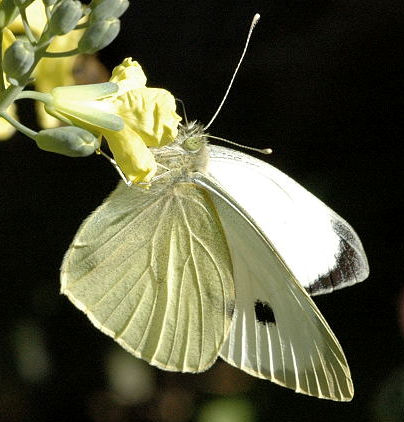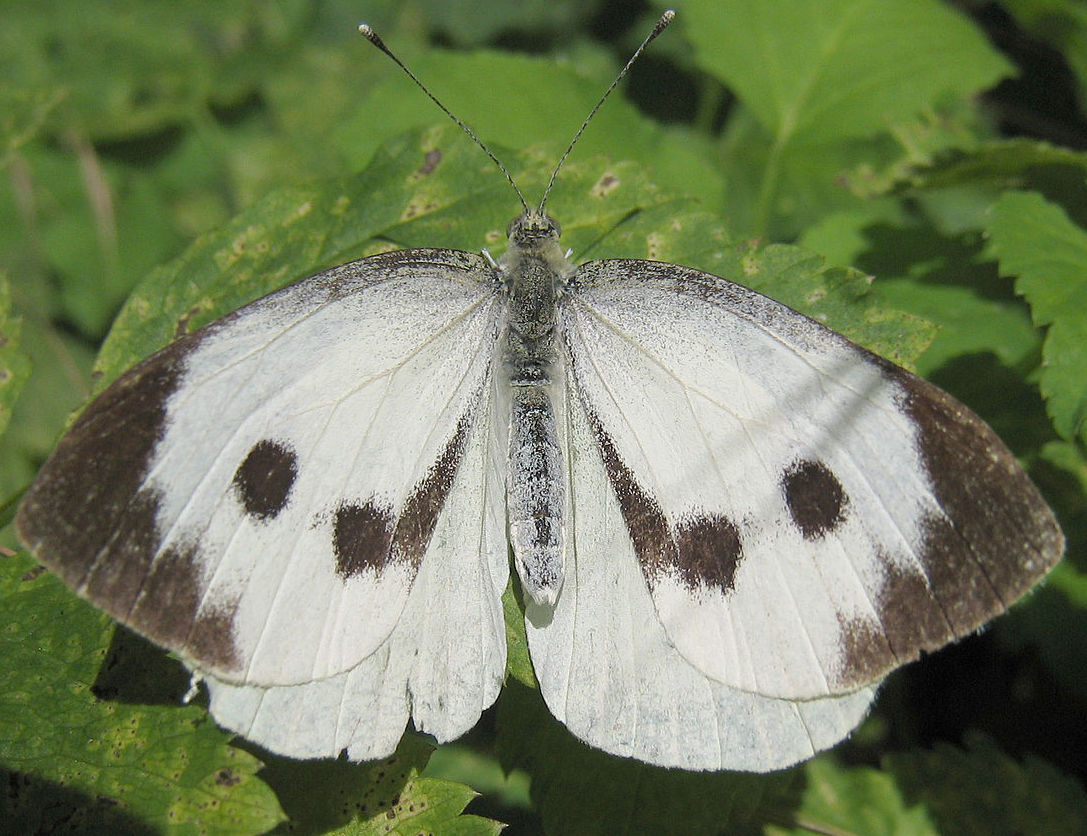- Home
- Garden Wildlife
- Insects
- Lepidoptera
- Butterflies
Biology
Butterflies are day-flying insects that are active from spring to autumn. They visit flowers in order to feed on nectar. Many garden flowers are attractive to them, particularly those growing in warm sheltered places. The larval stages feed mainly on the foliage of various plants. The large and small cabbage whites eat the foliage of cultivated plants, such as cabbage, other brassicas and nasturtiums. Other British butterflies have caterpillars that feed on forest trees or wild flowers, including nettles and grasses. UK butterflies has a comprehensive food plant list here.
Species that come to Britain as migrants include red admiral Vanessa atalanta, painted lady Vanessa cardui and less commonly in gardens, the clouded yellow, Colias croceus. The numbers that cross the Channel or North Sea can vary considerably from year to year. Those that arrive early enough are able to breed in Britain but they do not usually survive the winter. Climate change may change this, as in the case of the red admiral,
Life cycle
After mating, female butterflies deposit eggs on plants suitable for their larvae. Some butterflies lay eggs singly over many plants, while others lays eggs in clusters on a few plants. The caterpillars feed on the foliage or flower buds of their food plants. When fully fed, the caterpillars often wander away from their food plants before selecting somewhere to pupate. Most butterfly caterpillars pupate above ground level. They do not enclose themselves in a silk cocoon but silk threads are used to attach the pupa or chrysalis to a plant stem or fence.
Most butterflies overwinter as pupae but some species overwinter as eggs or larvae. The comma, brimstone, peacock and small tortoiseshell butterflies overwinter in sheltered places as adults. The last two mentioned sometimes hibernate in garden sheds and garages. Most species have one generation a year but some have two or sometimes three.
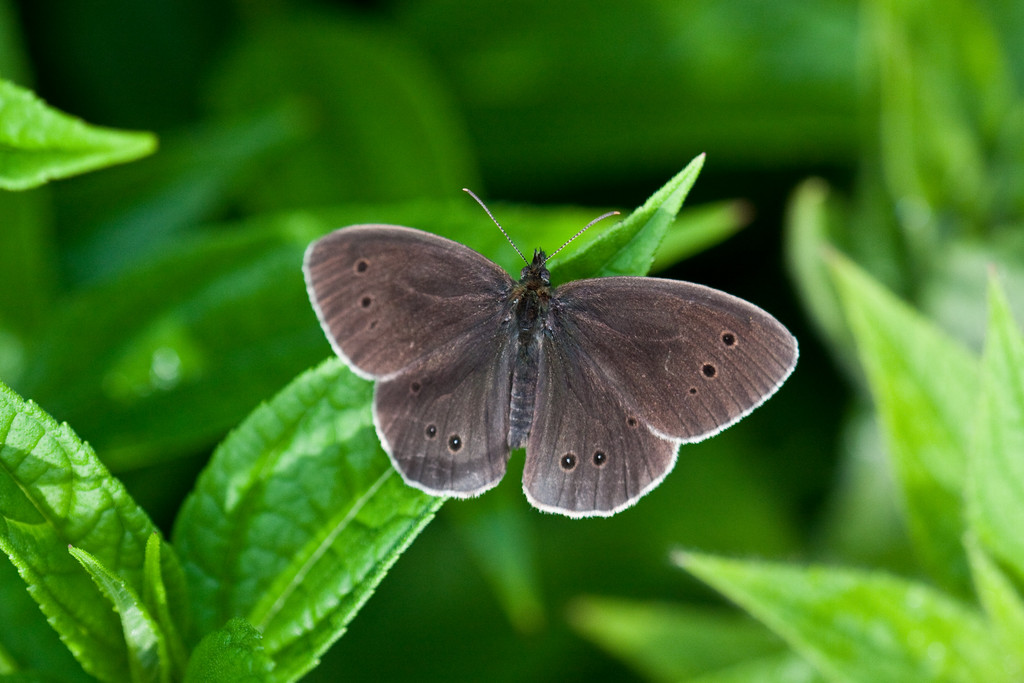
Butterflies
Butterflies are some of the most colourful insects to be seen in gardens. Their size and habit of visiting flowers on sunny days makes them easy to see and enjoy. There are however some day flying moths that could confuse.
Species in Britain and Ireland
There are 59 species of butterflies in Britain and Ireland, some of which come here as migrants from elsewhere in Europe and North Africa. Some butterflies have special habitat requirements, such as coppice woodland or chalk grassland and are unlikely to come into gardens. However, in long, hot summers when vegetation outside watered gardens has shrivelled, some strong-flying woodland edge species like the silver-washed fritillary and white admiral will come to gardens for the only available nectar.
Jennifer Owen recorded 23 species of butterflies in her garden, from malaise trap captures or hand-netting. By both techniques, the "whites" were overwhelmingly the commonest recorded, their numbers being much greater than all other species put together.
For the most complete information on British and Irish butterflies, inclding regional varieties and rare migrants, we recommend the excellent website of UK Butterflies, from which the summaries below have been composed. Photos of both males (left) and females(right) are shown when they are significantly different.
The 21 species (relatively) often seen in gardens include:
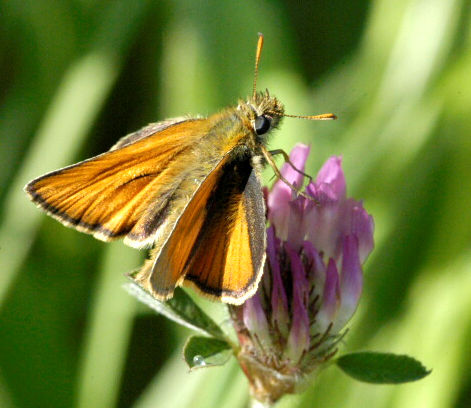
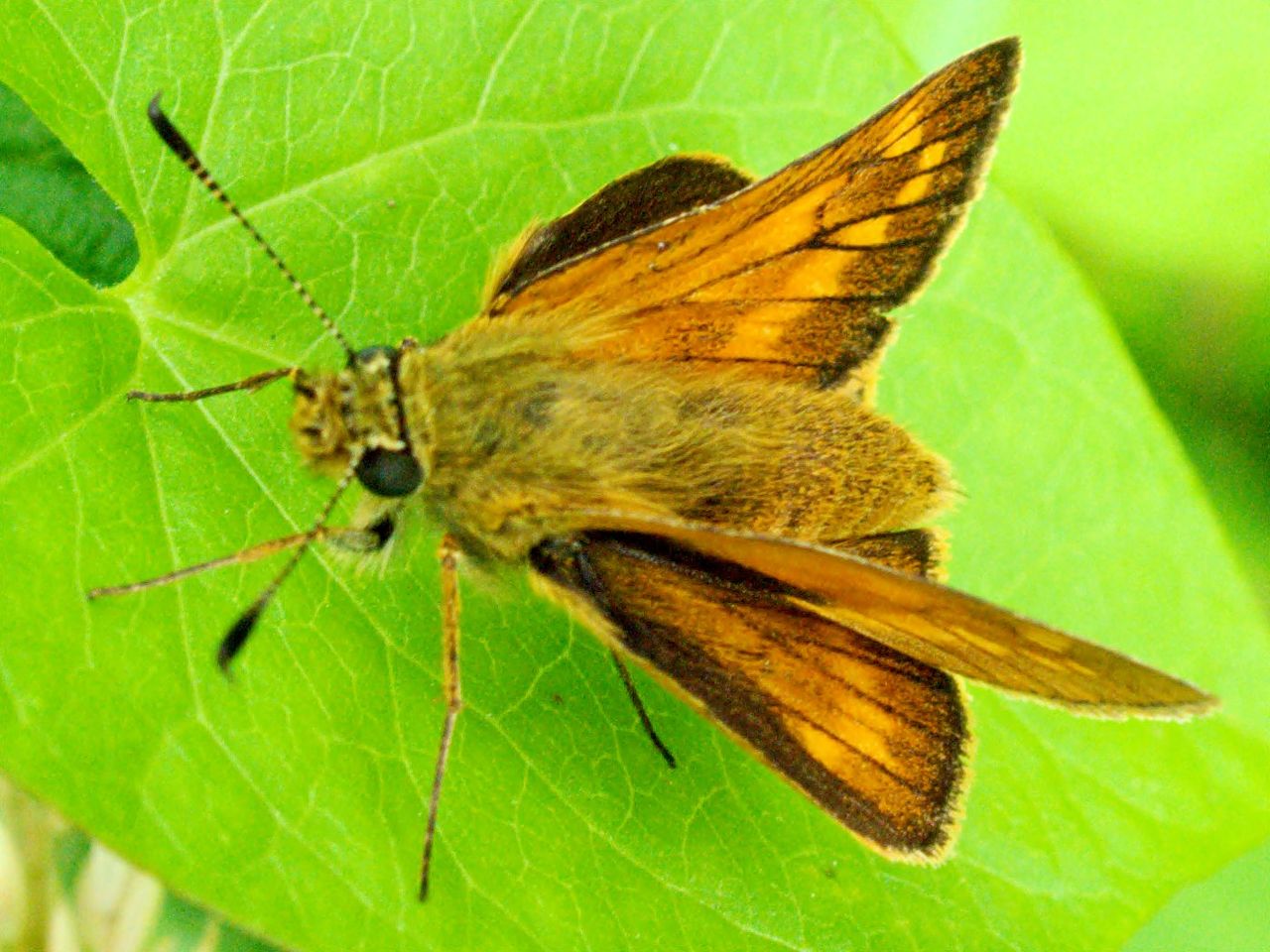
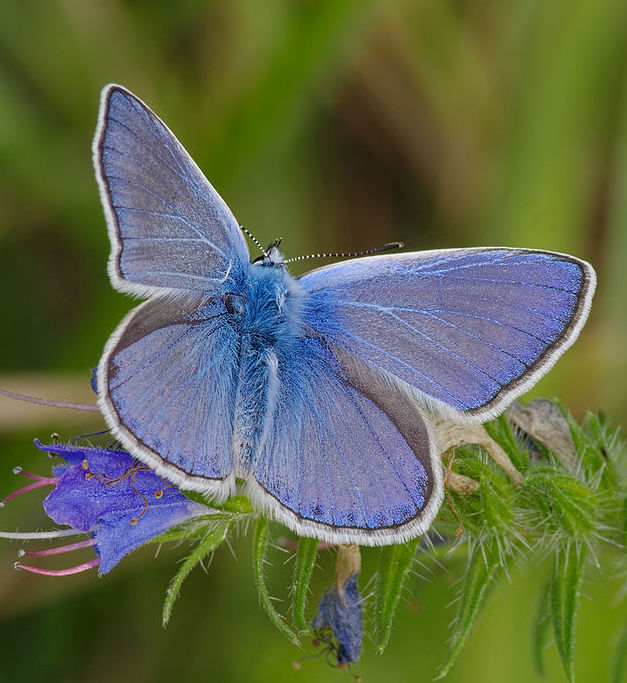
.jpg)
.jpg)
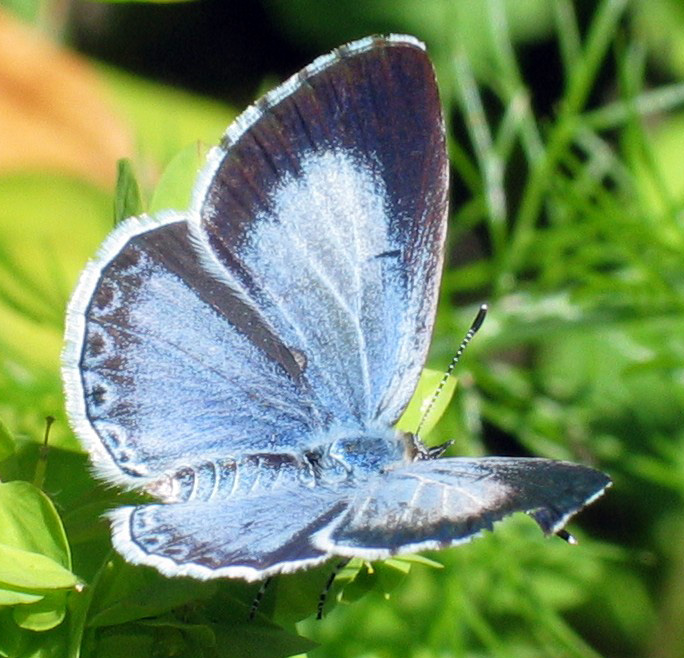
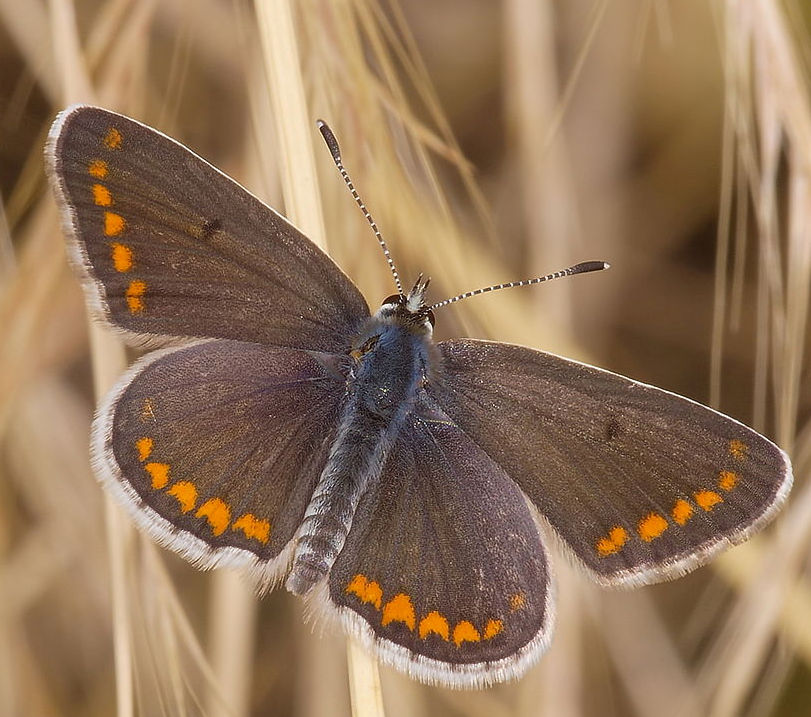
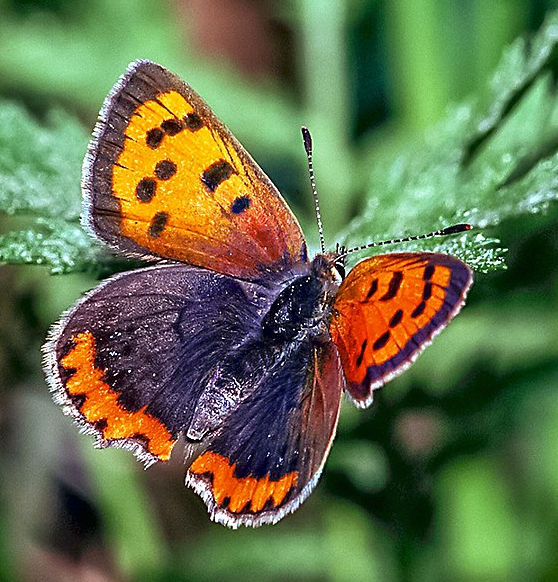
Skippers: Family Hesperiidae
Small skipper Thymelicus sylvestris
- Resident, rough grassland, common
- Adults: June-August
- Larval foodplants: grasses, Yorkshire fog Holcus lanatus
- Range: England and Wales north to Scottish border
- Status since 1970's : slight increase
Large skipper Ochlodes sylvanus
- Resident, tall grassland
- Adults: May-August
- Larval foodplants: grasses especially cocks-foot Dactylis glomerata
- Range: Southern Britain, extending northwards
- Status since 1970's : 12% decrease
Blues and coppers: Family Lycaenidae
Common blue Polyommatus icarus
- Resident
- Adults: 2 broods, May and October
- Larval foodplants: birds-foot trefoil Lotus corniculatus
- Range: All Britain and Ireland
- Status since 1970's : 17% decrease
Holly blue Celastrina argiolus
- Resident, common in gardens
- Adults: 2 broods, late March/April August/September
- Larval foodplants: 1st brood holly Ilex aquifolium 2nd brood ivy Hedera helix
- Range: Southern Britain and Ireland
- Status since 1970's : 37% increase
Small copper Lycaena phlaeas
- Resident, rare now in gardens
- Adults: up to 4 broods April to November
- Larval foodplants: sorrels Rumex acetosa and R. acetosella
- Range: All Britain and Ireland
- Status since 1970's : 37% decline
Brown argus Aricia agestis
- Resident, rare in gardens
- Adults: 2-3 broods May to Sept.
- Larval foodplants: common rock-rose Helianthemum nummularium
- Range: southern-eastern Britain, coastal Wales
- Status since 2005 : 2% increase, range increasing
Whites: Family Pieridae
Brimstone Gonepteryx rhamni
- Resident, common in gardens
- Adults: overwintering individuals April, offspring in August
- Larval foodplants: buckthorns Frangulus aldus & Rhamnus catharcticus
- Range: All Britain and Ireland
- Status since 1970's : 14% increase, range increasing
Large (cabbage) white Pieris brassicae
- Resident, augmented by summer migrants. Abundant
- Adults: usually 2 broods, April/May, July/August
- Larval foodplants: brassicas, nasturtium Tropaeolum majus
- Range:All Britain and Ireland
- Status since 1970's : 30% decrease but still abundant
Small (cabbage) white Pieris rapae
- Resident, augmented by summer migrants. Abundant
- Adults: usually 2 broods, April/June, July/August
- Larval foodplants: crucifers, nasturtium Tropaeolum majus
- Range: All Britain and Ireland
- Status since 1970's : 25% decrease but still common
Green-veined white Pieris napi
- Resident, common in gardens
- Adults: usually 2 broods, April/June, July/August
- Larval foodplants: charlock Sinapis arvensis, cuckoo-flower Cardamine pratensis
- Range: All Britain and Ireland
- Status since 2005: 72% increase
Orange-tip Anthocharis cardamines
- Resident, quite common in gardens
- Adults: 1 broods, April/June
- Larval foodplants: cuckoo-flower Cardamine pratensis
- Range: All Britain and Ireland except N. Scotland
- Status since 2005: 59% increase
Vanessids Sub family Nymphalinae
Red admiral, Vanessa atalanta Common
- Adults: Migrants from May, offspring July to October
- Larval foodplants: common nettle Urtica dioica
- Range: All Britain and Ireland
- Status since 2005: 257% increase
Painted lady Vanessa cardui
- Summer migrant, often common
- Adults: Migrants from April, offspring July to October
- Larval foodplants: thistles. common nettle Urtica dioica
- Range: All Britain and Ireland
- Status since 2005: 113% increase
Peacock, Inachis io
- Resident, common in gardens
- Adults: overwintering from January, offspring from June to December
- Larval foodplants: common nettle Urtica dioica
- Range: All Britain and Ireland except northern Scotland
- Status since 2005: 17% increase
Small tortoiseshell Aglais urticae
- Resident, common in gardens
- Adults: overwintering from January, offspring from July to December
- Larval foodplants: common nettle Urtica dioica
- Range: All Britain and Ireland
- Status since 2005: 73% decrease
Comma Polygonia c-album
- Resident, common in gardens
- Adults: overwintering from January, offspring from June to December
- Second brood eggs laid June to August, adults September to December
- Larval foodplants: hop, common nettle Urtica dioica
- Range: All England and Wales, now southern Scotland
- Status since 1970s: 150% increase, range extending north
Browns Sub-family Satyrinae
Speckled wood Pararge aegeria
- Resident, woodland habitat
- Adults: 2 broods April/May, June to October
- Larval foodplants: grasses, cocks-foot Dactylis glomerata and others
- Range: All Britain and Ireland, absent southern and central Scotland
- Status since 1970s: 84% increase
Ringlet Aphantopus hyperantus
- Resident, woodland edge habitat
- Adults: 1 brood June to August
- Larval foodplants: grasses, cocks-foot Dactylis glomerata and others
- Range: All Britain and Ireland, absent north western Scotland
- Status since 1970s: 381% increase, range extending
Wall Lasiommata megera
- Resident, now mainly in coastal areas
- Adults: 2 broods April/June August/September
- Larval foodplants: grasses, bents Agrostis spp and others
- Range: England and Wales, coastal Ireland
- Status since 1970s: 87% decrease, range reducing.
- BAP species
Gatekeeper Pyronia tithonus
- Resident, hedgerows, common in gardens
- Adults: 1 brood June to September
- Larval foodplants: grass, bents Agrostis spp, fescues Festuca spp
- Range: Southern & central England and Wales, south coastal Ireland
- Status since 1970s: 41% decrease
Meadow brown Maniola jurtina
- Resident, grassy habitats, common in gardens
- Adults: 1 brood June to September
- Larval foodplants: grasses, bents Agrostis spp, cocks-foot Dactylis glomerata
- Range: All Britain and Ireland
- Status since 1970s: stable
Other species
Jennifer Owen recorded single examples of the white-letter hairstreak Strymonidia w-album, silver-washed fritillary Argynnis paphia and marbled white Melanargia galathea, and 2 of the small heath Coenonympha pamphilus. If your garden adjoins a decent bit of countryside the last 2 species are more likely to be seen, and if you are next to a nature reserve it is very possible that some stronger fliers like the silver-washed fritillary may visit, especially in dry summers when gardens hold more nectar that the countryside.
Migrants
The clouded yellow Colias croceus is a migrant from Africa and southern Europe, appearing in very variable numbers in the summer. They have successfully overwintered in southern England, and could potentially become residents in the future. Most are seen in coastal areas of England, Wales and Ireland, but some come inland and can be seen in gardens. There are many other butterfly species which have been recorded very occasionally, and some probably arriving in cargo or escapees from captivity.
Potential new arrival?
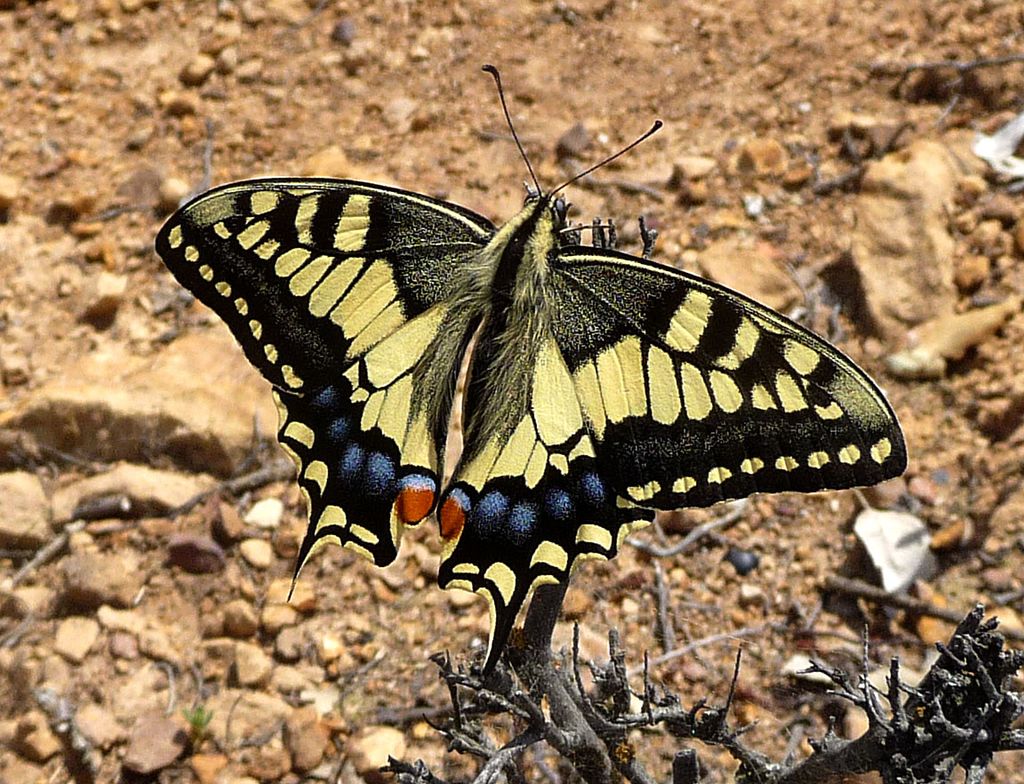
Our largest and arguably most attractive butterfly is the swallowtail Papilio machaon britannicus, but it only occurs in a few fenland localities in East Anglia, where its larva feeds only on milk-parsley Peucedanum palustre. The common central European sub-species Papilio machaon gorganus (left) has been spotted in England increasingly often in recent years.
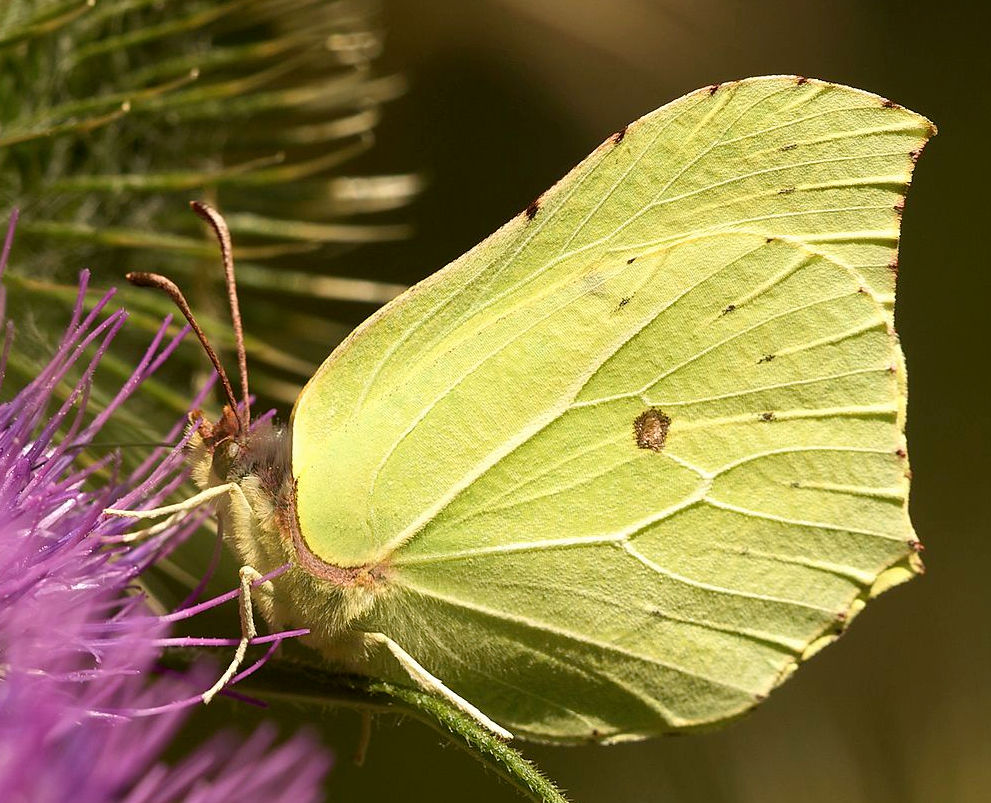
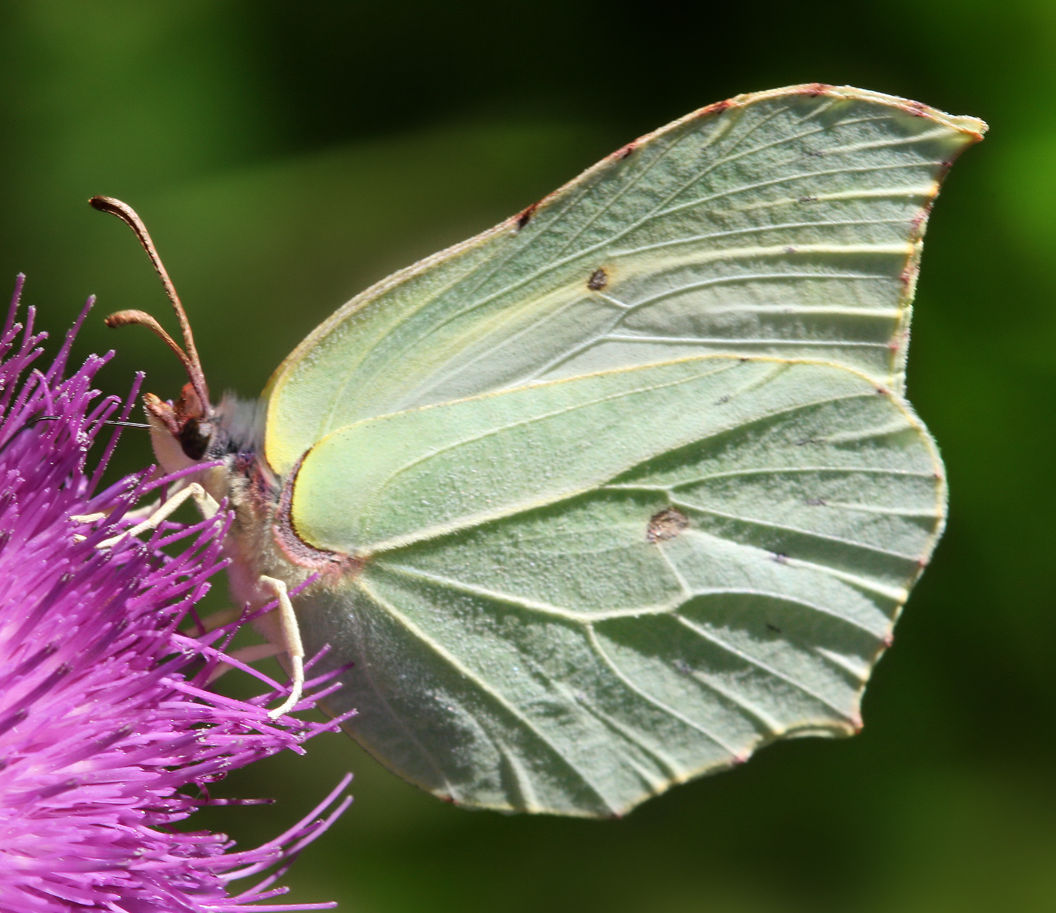
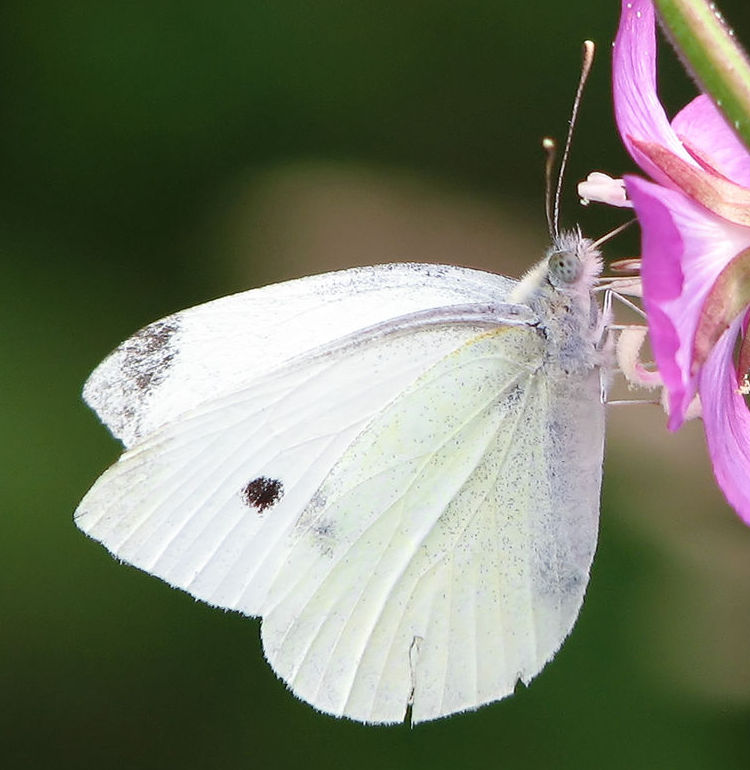
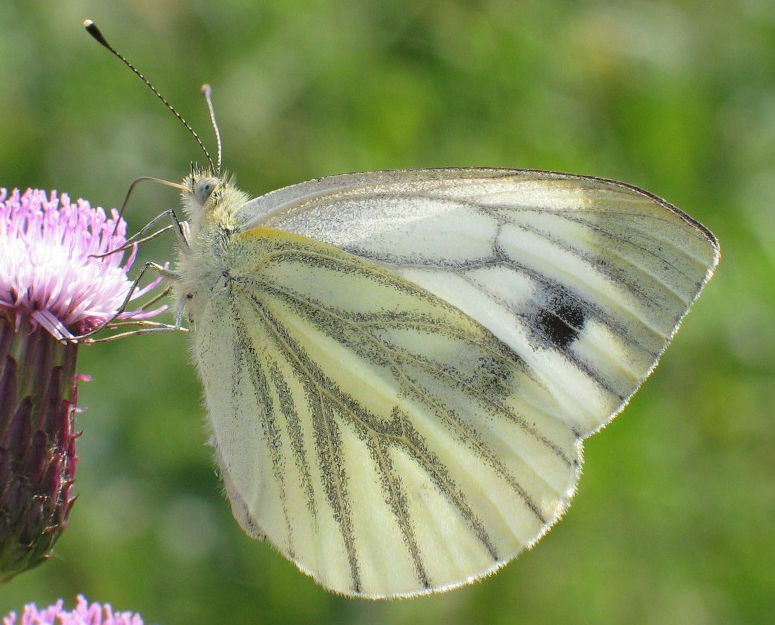
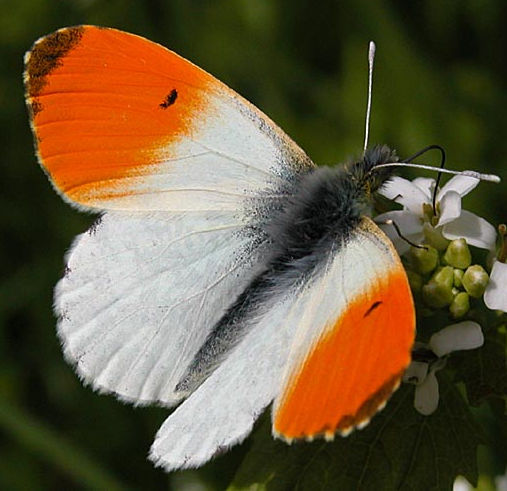
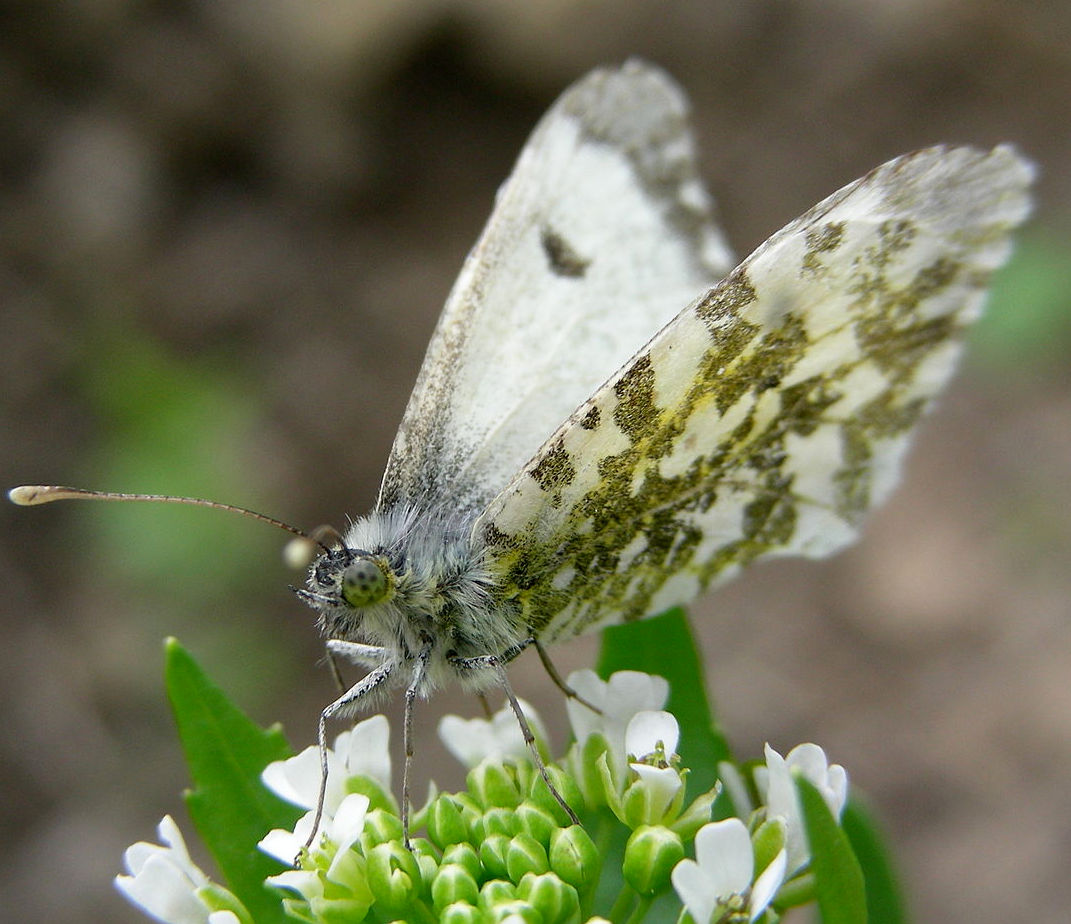
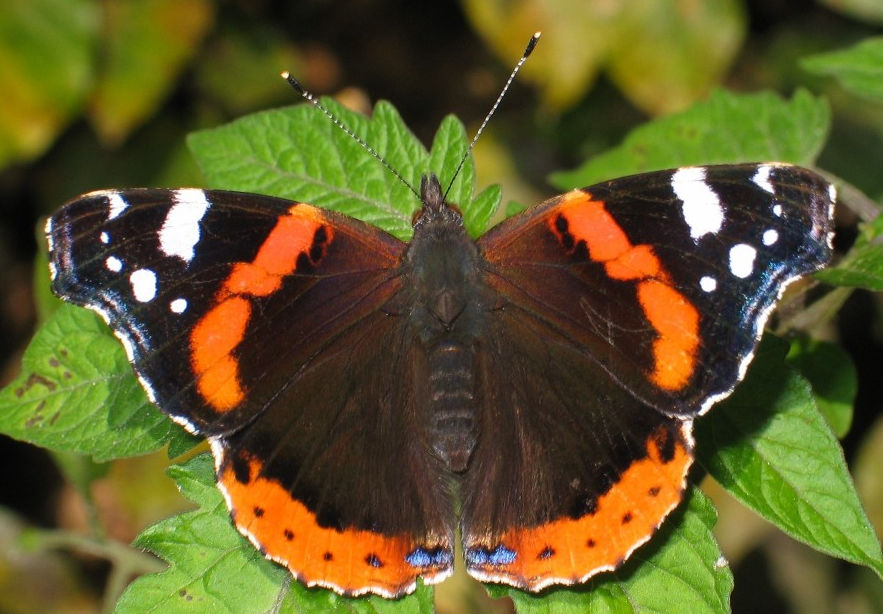
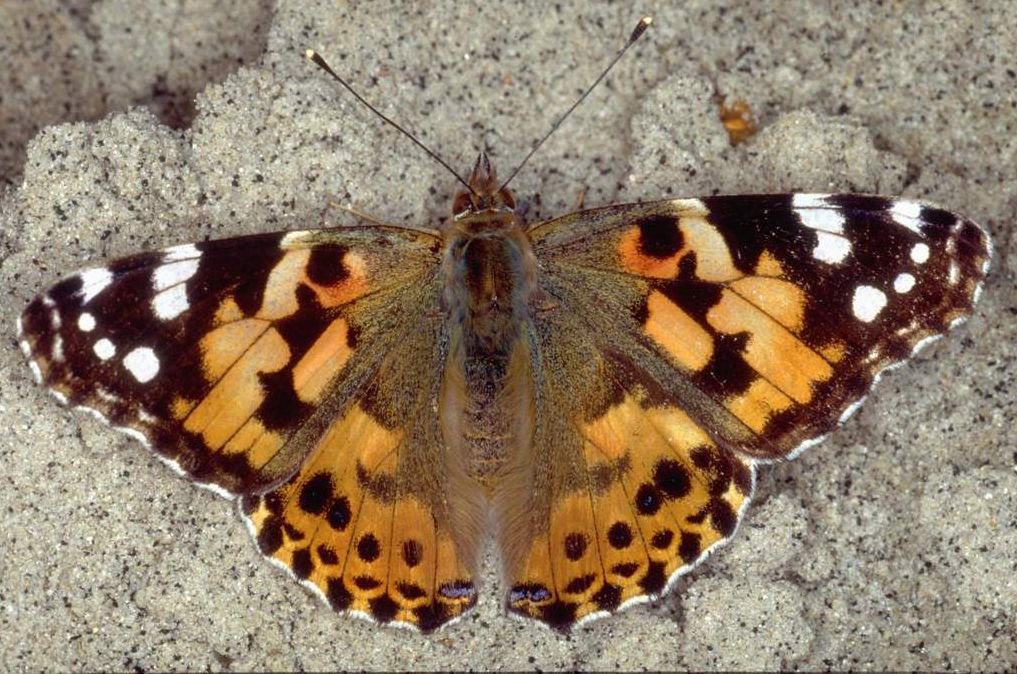
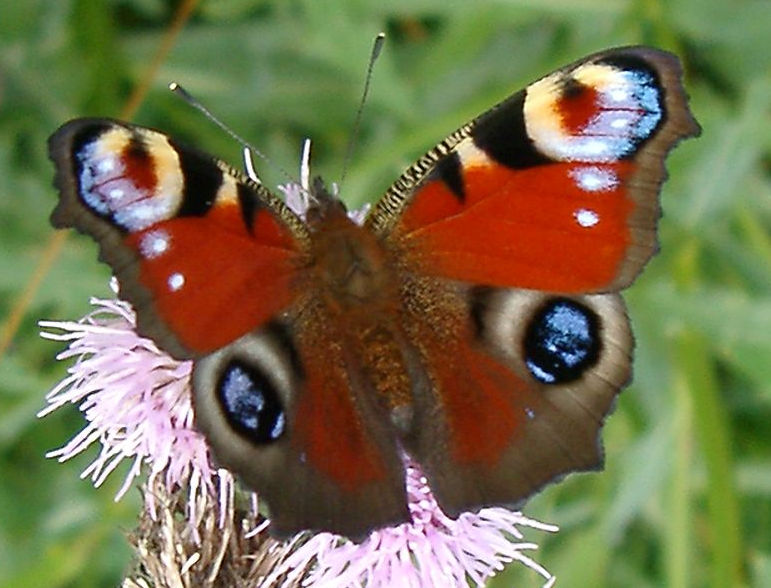
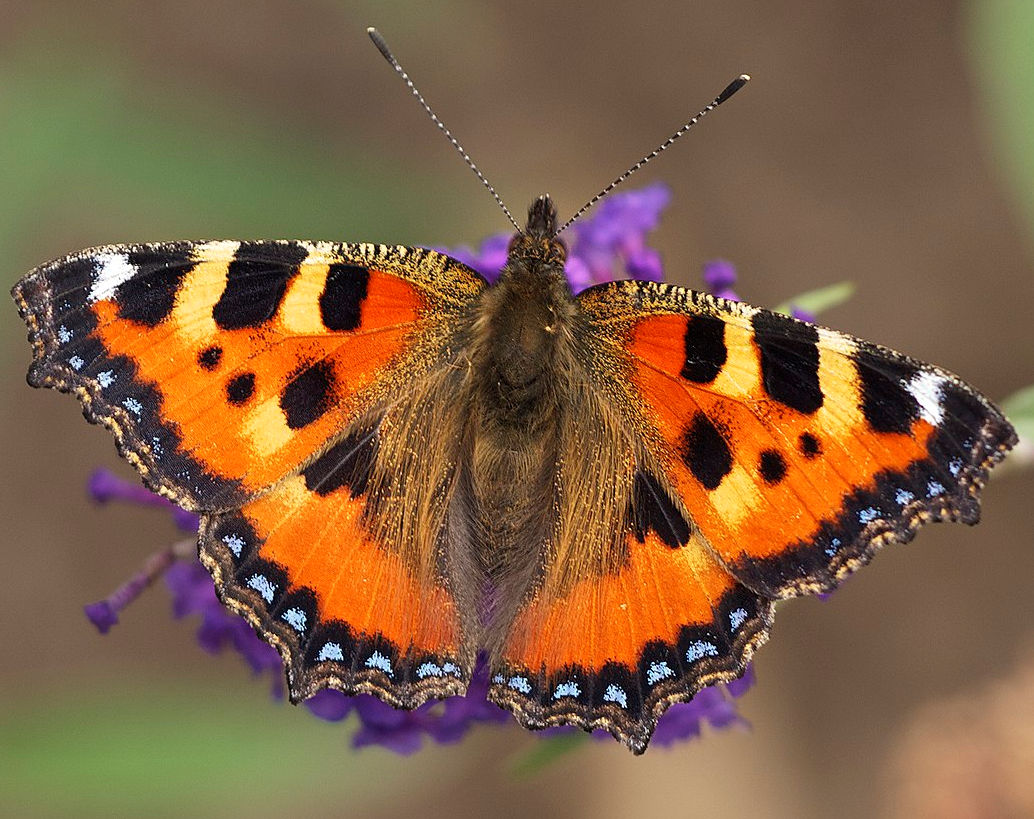
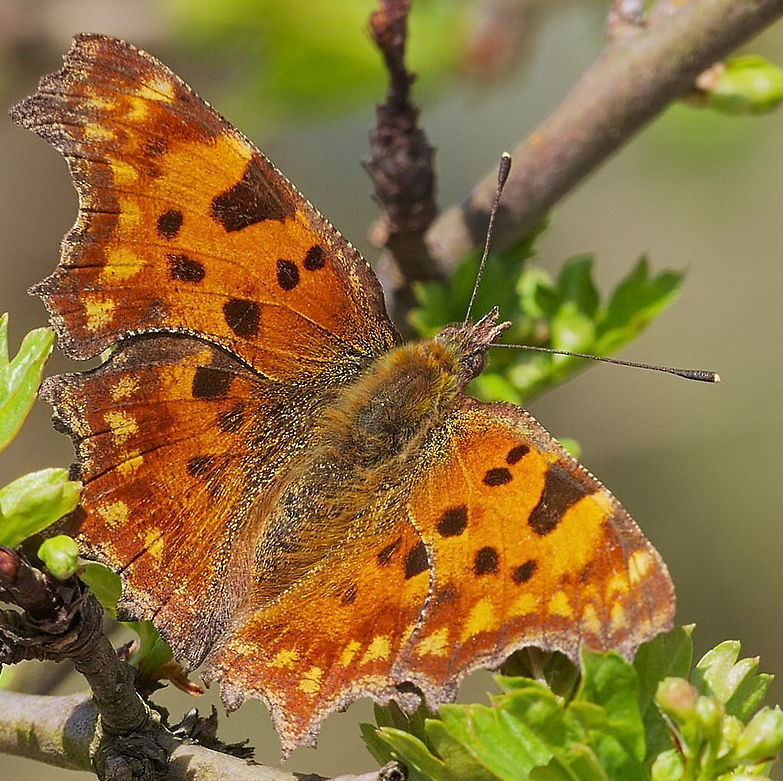
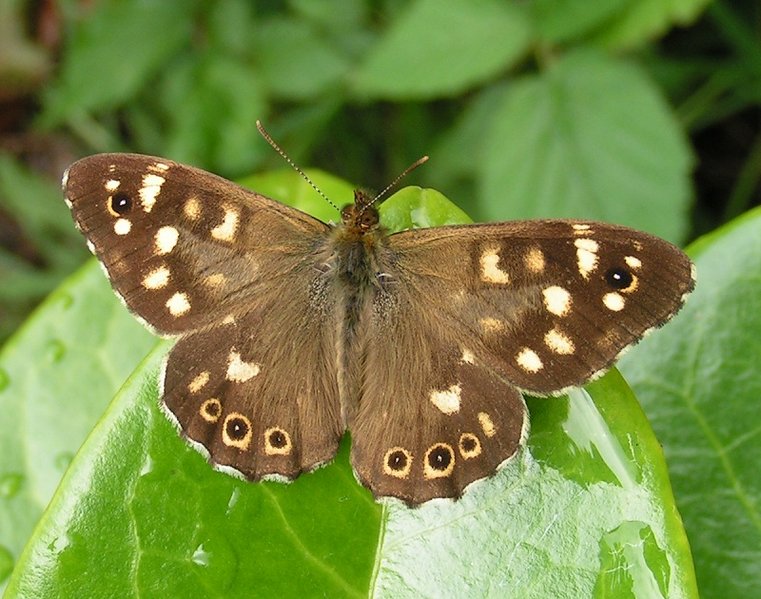
![Ringlet Photo: by Andreas Eichler [CC BY-SA 4.0 (https://creativecommons.org/licenses/by-sa/4.0)]](images/2014.07.06.-07-Sprotta--Schornsteinfeger.jpg)
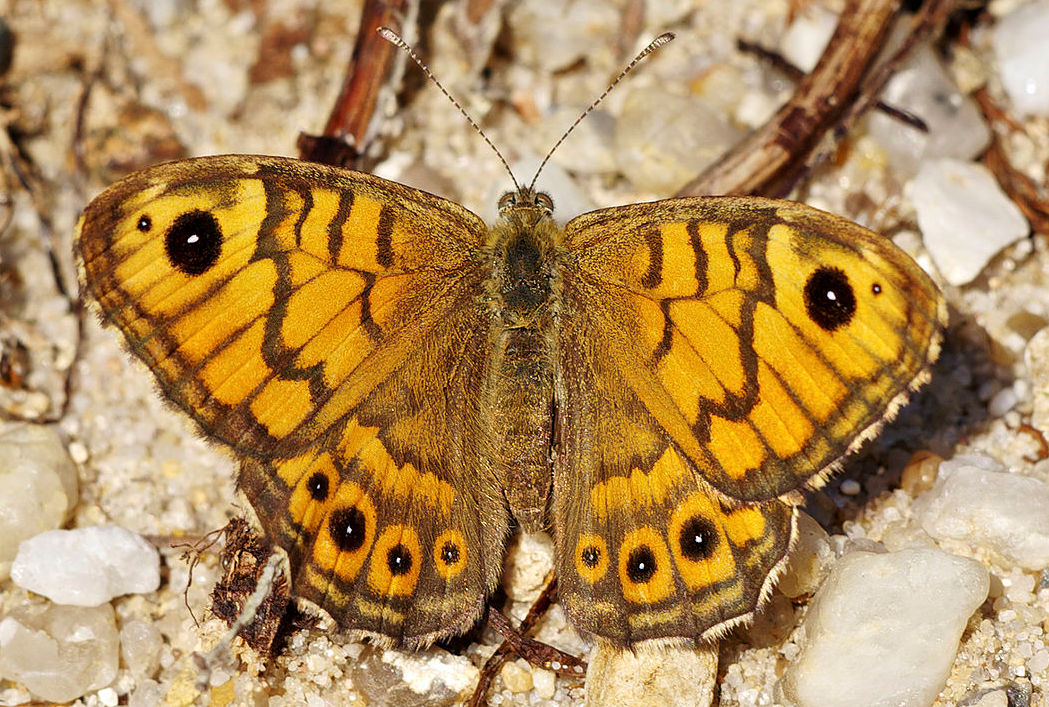
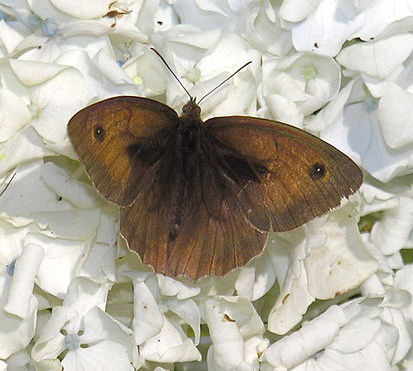
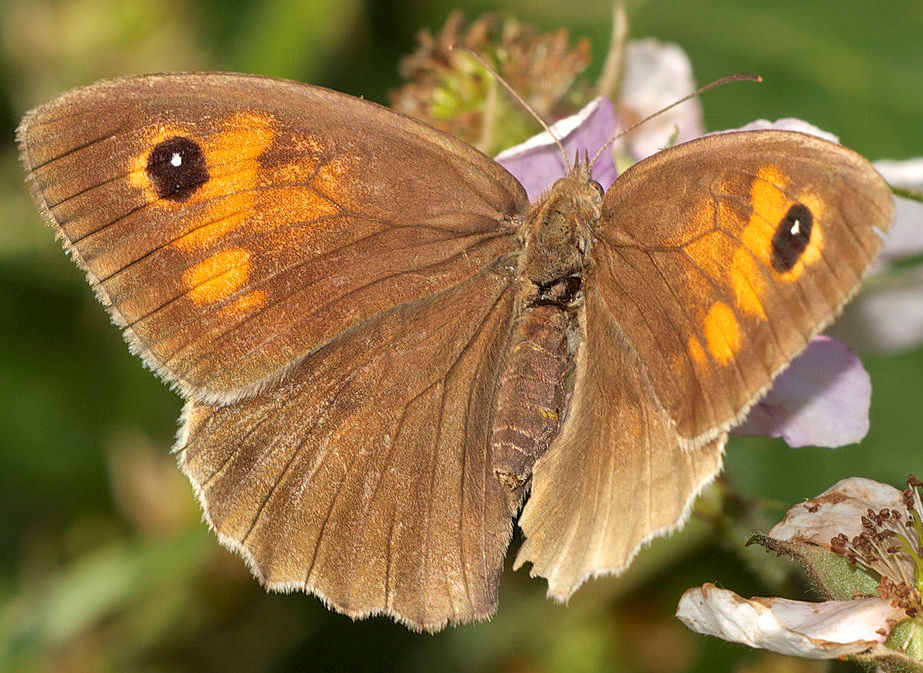
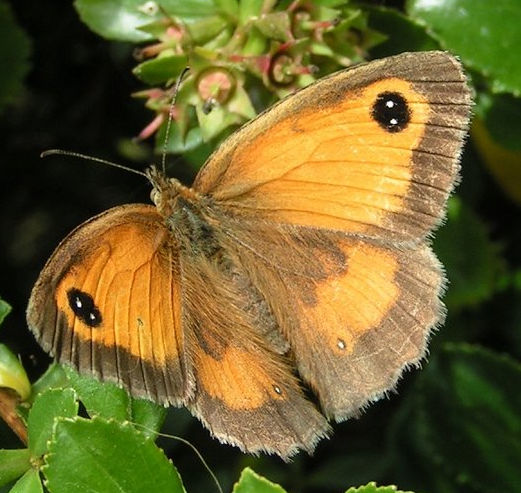
_male.jpg)
Large white life early stages: group of eggs, communal caterpillars, chrysalis with silken band around thorax
Role of butterflies in gardens
Butterflies are many people’s favourite insects and they add to the enjoyment of a garden. Although large and small cabbage white caterpillars can be very damaging to cabbages and other brassicas, other butterflies are harmless to garden plants. When visiting flowers to feed on nectar, butterflies have an opportunity to pick up pollen on their legs and bodies and so may help to pollinate flowers.
Encouraging butterflies in the garden
Attracting adults butterflies to your garden involves providing plenty of nectar-rich flowers in sunny flower beds, and leaving soft fruit to rot where they can feed on the juices. See our How-to guide.
To make a real difference however, we need to provide for all life stages of species, and this is a little difficult for butterflies, as many are quite food-plant specific, and don't feed as caterpillars on most conventional garden plants - except for the cabbage whites of course. This side of wildlife gardening has been rather neglected but is worth trying See the book by Jan Miller listed below.
It really is worth letting sections of your lawn grow long enough for the grass to flower. If you keep the margins trimmed, it will look "meant" rather than neglected, and you will provide habitat for "skippers" and many of the "browns" like the gatekeeper and meadow brown. Unfortunately most new lawns are pure dwarf perennial rye grass Lolium perenne which isn't a suitable foodplant. Bents Agrostis spp, Cocks-foot Dactylis glomerata, fescues Festuca spp, meadow grass Poa spp, hair-grass Deschampsia cespitosa and Yorkshire fog Holcus lanatus are all excellent. Old lawns will usually have a wider mix of species, but if you are considering replacing your lawn, consider some of the grass mixes available from specialist firms such as Emorsgate or Meadowmania.
The brimstone butterfly uses alder and common buckthorn, which are small trees which can readily be squeezed into a moderate garden. The orange tip uses lady's smock Cardamine pratensis and honesty Lunaria annua which are both happy in a cottage-garden planting. They also use garlic mustard Alliaria petiolata which flourishes at the back of a shady border and is coarse and smelly, but attractive in flower.
All "vanessids" use common or small nettle Urtica dioica and U. urens, but this doesn't mean they need to be planted! Only large patches (4m2) are favoured and they have to be in a sunny situation. Nettles are abundant everywhere on waste ground so only plant them if you really like them. Many vanessids also take hop Humulus lupulus, and the golden hop var "Aureus" is a good garden climber.
For the "blues", encouraging or tolerating ivy Hedera helix and planting holly Ilex aquifolium will almost guarantee the holly blue will breed. Common blue and small copper feed on what are normally consider meadow flowers, birds-foot trefoil and sorrels, but they are perfectly easy (easier in fact) to grow in a flower bed and seeds are readily available. However, little research has been done on how to encourage these species, and it isn't clear how large an area would be needed to be effective.
Other sources of information
Websites
Web site of Butterfly Conservation website
Report on the status of Britain’s butterflies
UK Butterflies website
Download our practical guide:
Books
Eeles, P. (2019) Life Cycles of British & Irish Butterflies. NatureBureau
Fox, R., Asher, J., Brereton, T., Roy, D. & Warren, M. (2006) The state of butterflies in Britain and Ireland. Pisces
Books
Miller, Jan (2010) Gardening for butterflies, birds and other benficial insects. Saith Ffynnon Books
Newland, D., Still, R., Tomlinson, D. & Swash, A. (2010) Britain’s Butterflies. WildGuides Ltd
Porter, J. (2010) Colour Identification Guide to the Caterpillars of the British Isles. Apollo BooksThomas, J.A. and
Lewington R. The Butterflies of Britain & Ireland. Bloomsbury publishing
Sterling, P., Henwood, B., Lewington, R. (2020) Field Guide to the Caterpillars of Great Britain and Ireland
Bloomsbury Wildlife Guides
Page drafted by Andrew Halstead, reviewed by Andrew Salisbury, edited by Steve Head
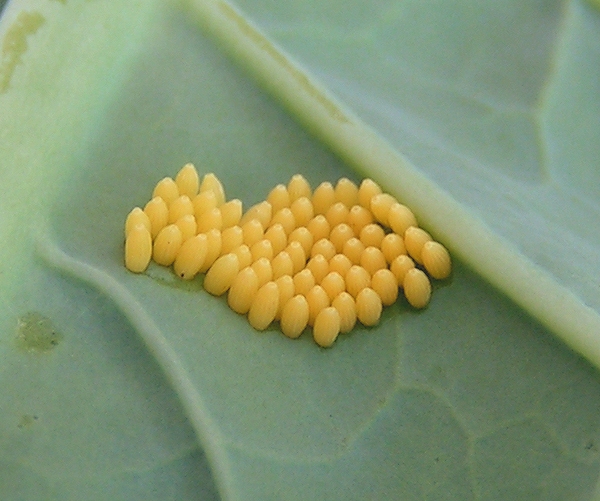
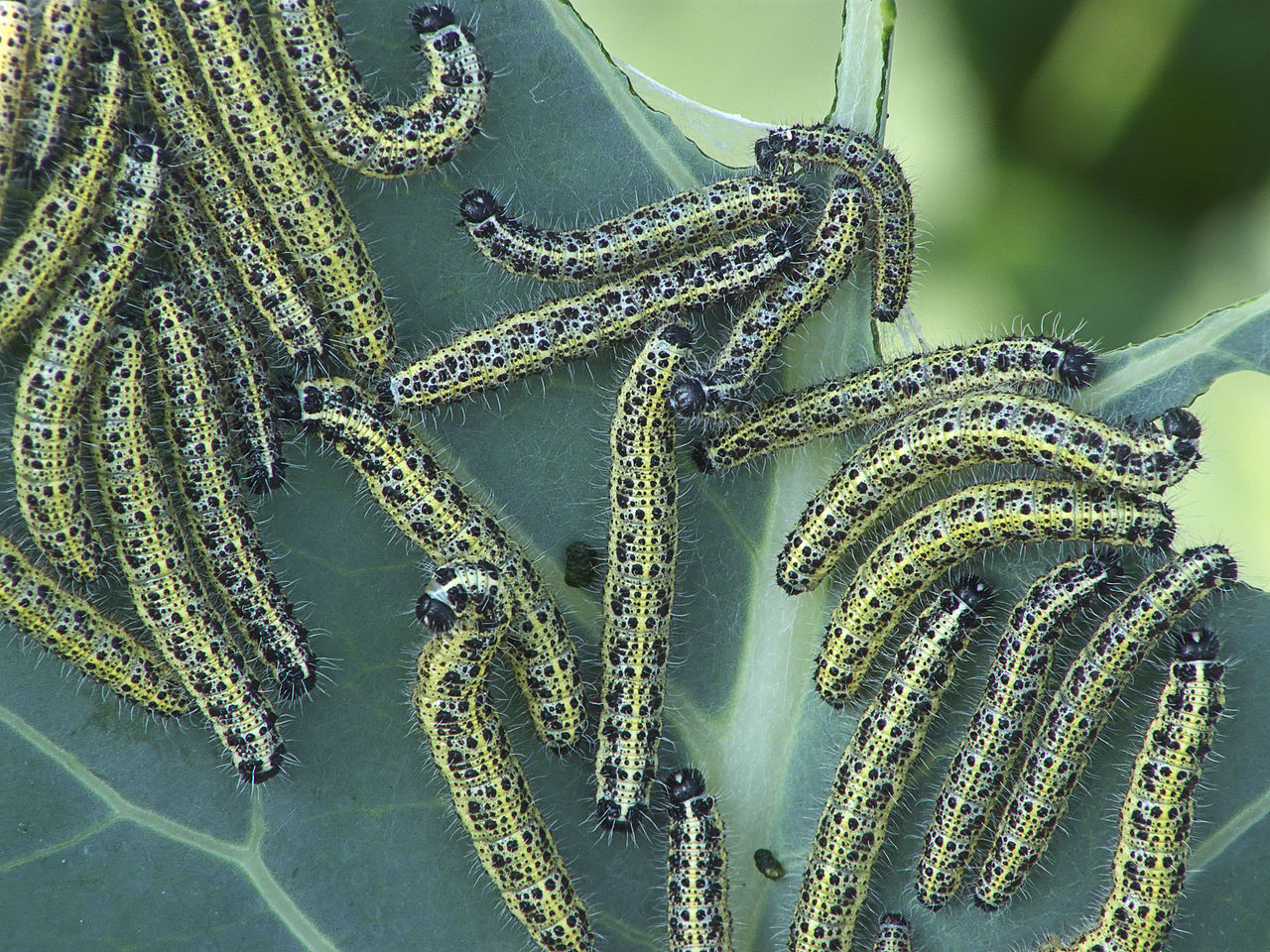
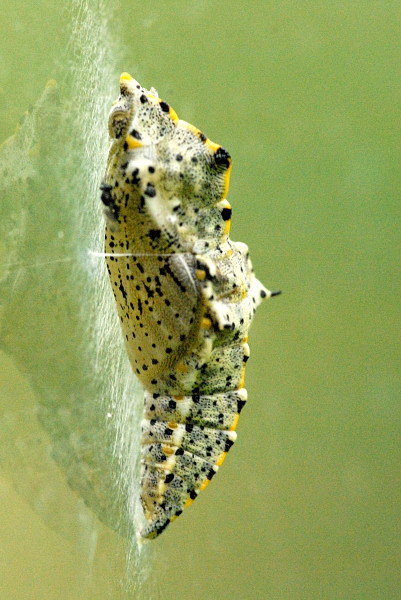
Butterflies
Butterflies are some of the most colourful insects to be seen in gardens. Their size and habit of visiting flowers on sunny days makes them easy to see and enjoy. There are however some day flying moths that could confuse.
Species in Britain and Ireland
There are 59 species of butterflies in Britain and Ireland, some of which come here as migrants from elsewhere in Europe and North Africa. Some butterflies have special habitat requirements, such as coppice woodland or chalk grassland and are unlikely to come into gardens. However, in long, hot summers when vegetation outside watered gardens has shrivelled, some strong-flying woodland edge species like the silver-washed fritillary and white admiral will come to gardens for the only available nectar.
Jennifer Owen recorded 23 species of butterflies in her garden, from malaise trap captures or hand-netting. By both techniques, the "whites" were overwhelmingly the commonest recorded, their numbers being much greater than all other species put together.
For the most complete information on British and Irish butterflies, inclding regional varieties and rare migrants, we recommend the excellent website of UK Butterflies, from which the summaries below have been composed. Photos of both males (left) and females (right) are shown when they are significantly different.
The 21 species (relatively) often seen in gardens include:



.jpg)
.jpg)



Small skipper Thymelicus sylvestris
- Resident, rough grassland, common
- Adults: June-August
- Larval foodplants: grasses, Yorkshire fog Holcus lanatus
- Range: England and Wales north to Scottish border
- Status since 1970's : slight increase
Large skipper Ochlodes sylvanus
- Resident, tall grassland
- Adults: May-August
- Larval foodplants: grasses especially cocks-foot Dactylis glomerata
- Range: Southern Britain, extending northwards
- Status since 1970's : 12% decrease
Common blue Polyommatus icarus
- Resident
- Adults: 2 broods, May and October
- Larval foodplants: birds-foot treioil Lotus corniculatus
- Range: All Britain and Ireland
- Status since 1970's : 17% decrease
Holly blue Celastrina argiolus
- Resident, common in gardens
- Adults: 2 broods, late March/April August/September
- Larval foodplants: 1st brood holly Ilex aquifolium 2nd brood ivy Hedera helix
- Range: Southern Britain and Ireland
- Status since 1970's : 37% increase
Small copper Lycaena phlaeas
- Resident, rare now in gardens
- Adults: up to 4 broods April to November
- Larval foodplants: sorrels Rumex acetosa and R. acetosella
- Range: All Britain and Ireland
- Status since 1970's : 37% decline
Brown argus Aricia agestis
- Resident, rare in gardens
- Adults: 2-3 broods May to Sept.
- Larval foodplants: common rock-rose Helianthemum nummularium
- Range: southern-eastern Britain, coastal Wales
- Status since 2005 : 2% increase, range increasing
Brimstone Gonepteryx rhamni
- Resident, common in gardens
- Adults: overwintering individuals in April, offspring in August
- Larval foodplants: buckthorns Frangulus aldus & Rhamnus catharcticus
- Range: All Britain and Ireland
- Status since 1970's : 14% increase, range increasing
Large (cabbage) white Pieris brassicae
- Resident, augmented by summer migrants. Abundant
- Adults: usually 2 broods, April/May, July/August
- Larval foodplants: brassicas, nasturtium Tropaeolum majus
- Range:All Britain and Ireland
- Status since 1970's : 30% decrease but still abundant
Small (cabbage) white Pieris rapae
- Resident, augmented by summer migrants. Abundant
- Adults: usually 2 broods, April/June, July/August
- Larval foodplants: crucifers, nasturtium Tropaeolum majus
- Range: All Britain and Ireland
- Status since 1970's : 25% decrease but still common
Green-veined white Pieris napi
- Resident, common in gardens
- Adults: usually 2 broods, April/June, July/August
- Larval foodplants: charlock Sinapis arvensis, cuckoo-flower Cardamine pratensis
- Range: All Britain and Ireland
- Status since 2005: 72% increase
Orange-tip Anthocharis cardamines
- Resident, quite common in gardens
- Adults: 1 broods, April/June
- Larval foodplants: cuckoo-flower Cardamine pratensis
- Range: All Britain and Ireland except northern Scotland
- Status since 2005: 59% increase
- Red admiral, Vanessa atalanta Common
- Adults: Migrants from May, offspring July to October
- Larval foodplants: common nettle Urtica dioica
- Range: All Britain and Ireland
- Status since 2005: 257% increase
Painted lady Vanessa cardui
- Summer migrant, often common
- Adults: Migrants from April, offspring July to October
- Larval foodplants: thistles. common nettle Urtica dioica
- Range: All Britain and Ireland
- Status since 2005: 113% increase
Peacock, Inachis io
- Resident, common in gardens
- Adults: overwintering from January, offspring from June to December
- Larval foodplants: common nettle Urtica dioica
- Range: All Britain and Ireland except northern Scotland
- Status since 2005: 17% increase
Small tortoiseshell Aglais urticae
- Resident, common in gardens
- Adults: overwintering from January, offspring from July to December
- Larval foodplants: common nettle Urtica dioica
- Range: All Britain and Ireland
- Status since 2005: 73% decrease
Comma Polygonia c-album
- Resident, common in gardens
- Adults: overwintering from January, offspring from June to December
- Second brood eggs laid June to August, adults September to December
- Larval foodplants: common nettle Urtica dioica
- Range: All England and Wales, now southern Scotland
- Status since 1970s: 150% increase, range extending north
Speckled wood Pararge aegeria
- Resident, woodland habitat
- Adults: 2 broods April/May, June to October
- Larval foodplants: grasses, cocks-foot Dactylis glomerata and others
- Range: All Britain and Ireland, absent southern and central Scotland
- Status since 1970s: 84% increase
Ringlet Aphantopus hyperantus
- Resident, woodland edge habitat
- Adults: 1 brood June to August
- Larval foodplants: grasses, cocks-foot Dactylis glomerata and others
- Range: All Britain and Ireland, absent north western Scotland
- Status since 1970s: 381% increase, range extending
Wall Lasiommata megera
- Resident, now mainly in coastal areas
- Adults: 2 broods April/June August/September
- Larval foodplants: grasses, bents Agrostis spp and others
- Range: England and Wales, coastal Ireland
- Status since 1970s: 87% decrease, range reducing.
- BAP species
Gatekeeper Pyronia tithonus
- Resident, hedgerows, common in gardens
- Adults: 1 brood June to September
- Larval foodplants: grass, bents Agrostis spp, fescues Festuca spp
- Range: Southern & central England and Wales, south coastal Ireland
- Status since 1970s: 41% decrease
Meadow brown Maniola jurtina
- Resident, grassy habitats, common in gardens
- Adults: 1 brood June to September
- Larval foodplants: grasses, bents Agrostis spp, cocks-foot Dactylis glomerata
- Range: All Britain and Ireland
- Status since 1970s: stable












![Ringlet Photo: by Andreas Eichler [CC BY-SA 4.0 (https://creativecommons.org/licenses/by-sa/4.0)]](images/2014.07.06.-07-Sprotta--Schornsteinfeger.jpg)

_male.jpg)



Small skipper Thymelicus sylvestris
- Resident, rough grassland, common
- Adults: June-August
- Larval foodplants: grasses, Yorkshire fog Holcus lanatus
- Range: England and Wales north to Scottish border
- Status since 1970's : slight increase
Large skipper Ochlodes sylvanus
- Resident, tall grassland
- Adults: May-August
- Larval foodplants: grasses especially cocks-foot Dactylis glomerata
- Range: Southern Britain, extending northwards
- Status since 1970's : 12% decrease
Common blue Polyommatus icarus
- Resident
- Adults: 2 broods, May and October
- Larval foodplants: birds-foot treioil Lotus corniculatus
- Range: All Britain and Ireland
- Status since 1970's : 17% decrease
Holly blue Celastrina argiolus
- Resident, common in gardens
- Adults: 2 broods, late March/April August/September
- Larval foodplants: 1st brood holly Ilex aquifolium 2nd brood ivy Hedera helix
- Range: Southern Britain and Ireland
- Status since 1970's : 37% increase
Small copper Lycaena phlaeas
- Resident, rare now in gardens
- Adults: up to 4 broods April to November
- Larval foodplants: sorrels Rumex acetosa and R. acetosella
- Range: All Britain and Ireland
- Status since 1970's : 37% decline
Brown argus Aricia agestis
- Resident, rare in gardens
- Adults: 2-3 broods May to Sept.
- Larval foodplants: common rock-rose Helianthemum nummularium
- Range: southern-eastern Britain, coastal Wales
- Status since 2005 : 2% increase, range increasing
Brimstone Gonepteryx rhamni
- Resident, common in gardens
- Adults: overwintering individuals in April, offspring in August
- Larval foodplants: buckthorns Frangulus aldus & Rhamnus catharcticus
- Range: All Britain and Ireland
- Status since 1970's : 14% increase, range increasing
Large (cabbage) white Pieris brassicae
- Resident, augmented by summer migrants. Abundant
- Adults: usually 2 broods, April/May, July/August
- Larval foodplants: brassicas, nasturtium Tropaeolum majus
- Range:All Britain and Ireland
- Status since 1970's : 30% decrease but still abundant
Small (cabbage) white Pieris rapae
- Resident, augmented by summer migrants. Abundant
- Adults: usually 2 broods, April/June, July/August
- Larval foodplants: crucifers, nasturtium Tropaeolum majus
- Range: All Britain and Ireland
- Status since 1970's : 25% decrease but still common
Green-veined white Pieris napi
- Resident, common in gardens
- Adults: usually 2 broods, April/June, July/August
- Larval foodplants: charlock Sinapis arvensis, cuckoo-flower Cardamine pratensis
- Range: All Britain and Ireland
- Status since 2005: 72% increase
Orange-tip Anthocharis cardamines
- Resident, quite common in gardens
- Adults: 1 broods, April/June
- Larval foodplants: cuckoo-flower Cardamine pratensis
- Range: All Britain and Ireland except northern Scotland
- Status since 2005: 59% increase
- Red admiral, Vanessa atalanta Common
- Adults: Migrants from May, offspring July to October
- Larval foodplants: common nettle Urtica dioica
- Range: All Britain and Ireland
- Status since 2005: 257% increase
Painted lady Vanessa cardui
- Summer migrant, often common
- Adults: Migrants from April, offspring July to October
- Larval foodplants: thistles. common nettle Urtica dioica
- Range: All Britain and Ireland
- Status since 2005: 113% increase
Peacock, Inachis io
- Resident, common in gardens
- Adults: overwintering from January, offspring from June to December
- Larval foodplants: common nettle Urtica dioica
- Range: All Britain and Ireland except northern Scotland
- Status since 2005: 17% increase
Small tortoiseshell Aglais urticae
- Resident, common in gardens
- Adults: overwintering from January, offspring from July to December
- Larval foodplants: common nettle Urtica dioica
- Range: All Britain and Ireland
- Status since 2005: 73% decrease
Comma Polygonia c-album
- Resident, common in gardens
- Adults: overwintering from January, offspring from June to December
- Second brood eggs laid June to August, adults September to December
- Larval foodplants: common nettle Urtica dioica
- Range: All England and Wales, now southern Scotland
- Status since 1970s: 150% increase, range extending north
Speckled wood Pararge aegeria
- Resident, woodland habitat
- Adults: 2 broods April/May, June to October
- Larval foodplants: grasses, cocks-foot Dactylis glomerata and others
- Range: All Britain and Ireland, absent southern and central Scotland
- Status since 1970s: 84% increase
Ringlet Aphantopus hyperantus
- Resident, woodland edge habitat
- Adults: 1 brood June to August
- Larval foodplants: grasses, cocks-foot Dactylis glomerata and others
- Range: All Britain and Ireland, absent north western Scotland
- Status since 1970s: 381% increase, range extending
Wall Lasiommata megera
- Resident, now mainly in coastal areas
- Adults: 2 broods April/June August/September
- Larval foodplants: grasses, bents Agrostis spp and others
- Range: England and Wales, coastal Ireland
- Status since 1970s: 87% decrease, range reducing.
- BAP species
Gatekeeper Pyronia tithonus
- Resident, hedgerows, common in gardens
- Adults: 1 brood June to September
- Larval foodplants: grass, bents Agrostis spp, fescues Festuca spp
- Range: Southern & central England and Wales, south coastal Ireland
- Status since 1970s: 41% decrease
Meadow brown Maniola jurtina
- Resident, grassy habitats, common in gardens
- Adults: 1 brood June to September
- Larval foodplants: grasses, bents Agrostis spp, cocks-foot Dactylis glomerata
- Range: All Britain and Ireland
- Status since 1970s: stable
Other species
Jennifer Owen recorded single examples of the white-letter hairstreak Strymonidia w-album, silver-washed fritillary Argynnis paphia and marbled white Melanargia galathea, and 2 of the small heath Coenonympha pamphilus. If your garden adjoins a decent bit of countryside the last 2 species are more likely to be seen, and if you are next to a nature reserve it is very possible that some stronger fliers like the silver-washed fritillary may visit, especially in dry summers when gardens hold more nectar that the countryside.
Migrants
The clouded yellow Colias croceus is a migrant from Africa and southern Europe, appearing in very variable numbers in the summer. They have successfully overwintered in southern England, and could potentially become residents in the future. Most are seen in coastal areas of England, Wales and Ireland, but some come inland and can be seen in gardens. There are many other butterfly species which have been recorded very occasionally, and some probably arriving in cargo or escapees from captivity.
Potential new arrival?

Small skipper Thymelicus sylvestris
- Resident, rough grassland, common
- Adults: June-August
- Larval foodplants: grasses, Yorkshire fog Holcus lanatus
- Range: England and Wales north to Scottish border
- Status since 1970's : slight increase
Large skipper Ochlodes sylvanus
- Resident, tall grassland
- Adults: May-August
- Larval foodplants: grasses especially cocks-foot Dactylis glomerata
- Range: Southern Britain, extending northwards
- Status since 1970's : 12% decrease
Common blue Polyommatus icarus
- Resident
- Adults: 2 broods, May and October
- Larval foodplants: birds-foot trefoil Lotus corniculatus
- Range: All Britain and Ireland
- Status since 1970's : 17% decrease
Holly blue Celastrina argiolus
- Resident, common in gardens
- Adults: 2 broods, late March/April August/September
- Larval foodplants: 1st brood holly Ilex aquifolium 2nd brood ivy Hedera helix
- Range: Southern Britain and Ireland
- Status since 1970's : 37% increase
Small copper Lycaena phlaeas
- Resident, rare now in gardens
- Adults: up to 4 broods April to November
- Larval foodplants: sorrels Rumex acetosa and R. acetosella
- Range: All Britain and Ireland
- Status since 1970's : 37% decline
Brown argus Aricia agestis
- Resident, rare in gardens
- Adults: 2-3 broods May to Sept.
- Larval foodplants: common rock-rose Helianthemum nummularium
- Range: southern-eastern Britain, coastal Wales
- Status since 2005 : 2% increase, range increasing
Brimstone Gonepteryx rhamni
- Resident, common in gardens
- Adults: overwintering individuals in April, offspring in August
- Larval foodplants: buckthorns Frangulus aldus & Rhamnus catharcticus
- Range: All Britain and Ireland
- Status since 1970's : 14% increase, range increasing
Large (cabbage) white Pieris brassicae
- Resident, augmented by summer migrants. Abundant
- Adults: usually 2 broods, April/May, July/August
- Larval foodplants: brassicas, nasturtium Tropaeolum majus
- Range:All Britain and Ireland
- Status since 1970's : 30% decrease but still abundant
Small (cabbage) white Pieris rapae
- Resident, augmented by summer migrants. Abundant
- Adults: usually 2 broods, April/June, July/August
- Larval foodplants: crucifers, nasturtium Tropaeolum majus
- Range: All Britain and Ireland
- Status since 1970's : 25% decrease but still common
Green-veined white Pieris napi
- Resident, common in gardens
- Adults: usually 2 broods, April/June, July/August
- Larval foodplants: charlock Sinapis arvensis, cuckoo-flower Cardamine pratensis
- Range: All Britain and Ireland
- Status since 2005: 72% increase
Orange-tip Anthocharis cardamines
- Resident, quite common in gardens
- Adults: 1 broods, April/June
- Larval foodplants: cuckoo-flower Cardamine pratensis
- Range: All Britain and Ireland except northern Scotland
- Status since 2005: 59% increase
- Red admiral, Vanessa atalanta Common
- Adults: Migrants from May, offspring July to October
- Larval foodplants: common nettle Urtica dioica
- Range: All Britain and Ireland
- Status since 2005: 257% increase
Painted lady Vanessa cardui
- Summer migrant, often common
- Adults: Migrants from April, offspring July to October
- Larval foodplants: thistles. common nettle Urtica dioica
- Range: All Britain and Ireland
- Status since 2005: 113% increase
Peacock, Inachis io
- Resident, common in gardens
- Adults: overwintering from January, offspring from June to December
- Larval foodplants: common nettle Urtica dioica
- Range: All Britain and Ireland except northern Scotland
- Status since 2005: 17% increase
Small tortoiseshell Aglais urticae
- Resident, common in gardens
- Adults: overwintering from January, offspring from July to December
- Larval foodplants: common nettle Urtica dioica
- Range: All Britain and Ireland
- Status since 2005: 73% decrease
Comma Polygonia c-album
- Resident, common in gardens
- Adults: overwintering from January, offspring from June to December
- Second brood eggs laid June to August, adults September to December
- Larval foodplants: hop, common nettle Urtica dioica
- Range: All England and Wales, now southern Scotland
- Status since 1970s: 150% increase, range extending north
Speckled wood Pararge aegeria
- Resident, woodland habitat
- Adults: 2 broods April/May, June to October
- Larval foodplants: grasses, cocks-foot Dactylis glomerata and others
- Range: All Britain and Ireland, absent southern and central Scotland
- Status since 1970s: 84% increase
Ringlet Aphantopus hyperantus
- Resident, woodland edge habitat
- Adults: 1 brood June to August
- Larval foodplants: grasses, cocks-foot Dactylis glomerata and others
- Range: All Britain and Ireland, absent north western Scotland
- Status since 1970s: 381% increase, range extending
Wall Lasiommata megera
- Resident, now mainly in coastal areas
- Adults: 2 broods April/June August/September
- Larval foodplants: grasses, bents Agrostis spp and others
- Range: England and Wales, coastal Ireland
- Status since 1970s: 87% decrease, range reducing.
- BAP species
Gatekeeper Pyronia tithonus
- Resident, hedgerows, common in gardens
- Adults: 1 brood June to September
- Larval foodplants: grass, bents Agrostis spp, fescues Festuca spp
- Range: Southern & central England and Wales, south coastal Ireland
- Status since 1970s: 41% decrease
Meadow brown Maniola jurtina
- Resident, grassy habitats, common in gardens
- Adults: 1 brood June to September
- Larval foodplants: grasses, bents Agrostis spp, cocks-foot Dactylis glomerata
- Range: All Britain and Ireland
- Status since 1970s: stable
Our largest and arguably most attractive butterfly is the swallowtail Papilio machaon britannicus, but it only occurs in a few fenland localities in East Anglia, where its larva feeds only on milk-parsley Peucedanum palustre. The common central European sub-species Papilio machaon gorganus (left) has been spotted in England increasingly often in recent years.
It has been found to lay eggs here, which survived and emerged as adults the following spring. This range extension is probably linked to climate change. Importantly, the European sub-species feeds on a much wider range of common umbellifer food plants, including wild carrot Daucus carota, wild angelica Angelica sylvestris and hogweeds Heracleum spp. All of these are grown deliberately (or accidentally) in UK gardens - so - lets live in hope!



Biology
Butterflies are day-flying insects that are active from spring to autumn. They visit flowers in order to feed on nectar. Many garden flowers are attractive to them, particularly those growing in warm sheltered places. The larval stages feed mainly on the foliage of various plants. The large and small cabbage whites eat the foliage of cultivated plants, such as cabbage, other brassicas and nasturtiums. Other British butterflies have caterpillars that feed on forest trees or wild flowers, including nettles and grasses.
Species that come to Britain as migrants include red admiral Vanessa atalanta, painted lady Vanessa cardui and less commonly in gardens, the clouded yellow, Colias croceus. The numbers that cross the Channel or North Sea can vary considerably from year to year. Those that arrive early enough are able to breed in Britain but they do not usually survive the winter. Climate change may change this, as in the case of the red admiral,
Life cycle
After mating, female butterflies deposit eggs on plants suitable for their larvae. Some butterflies lay eggs singly over many plants, while others lays eggs in clusters on a few plants. The caterpillars feed on the foliage or flower buds of their food plants. When fully fed, the caterpillars often wander away from their food plants before selecting somewhere to pupate. Most butterfly caterpillars pupate above ground level. They do not enclose themselves in a silk cocoon but silk threads are used to attach the pupa or chrysalis to a plant stem or fence.
Most butterflies overwinter as pupae but some species overwinter as eggs or larvae. The comma, brimstone, peacock and small tortoiseshell butterflies overwinter in sheltered places as adults. The last two mentioned sometimes hibernate in garden sheds and garages. Most species have one generation a year but some have two or sometimes three.
It has been found to lay eggs here, which survived and emerged as adults the following spring. This range extension is probably linked to climate change.
Importantly, the European sub-species feeds on a much wider range of common umbellifer food plants, including wild carrot Daucus carota, wild angelica Angelica sylvestris and hogweeds Heracleum spp. All of these are grown deliberately (or accidentally) in UK gardens - so - lets live in hope!
Biology
Butterflies are day-flying insects that are active from spring to autumn. They visit flowers in order to feed on nectar. Many garden flowers are attractive to them, particularly those growing in warm sheltered places. The larval stages feed mainly on the foliage of various plants. The large and small cabbage whites eat the foliage of cultivated plants, such as cabbage, other brassicas and nasturtiums. Other British butterflies have caterpillars that feed on forest trees or wild flowers, including nettles and grasses. UK butterflies has a comprehensive food plant list here.
Species that come to Britain as migrants include red admiral Vanessa atalanta, painted lady Vanessa cardui and less commonly in gardens, the clouded yellow, Colias croceus. The numbers that cross the Channel or North Sea can vary considerably from year to year. Those that arrive early enough are able to breed in Britain but they do not usually survive the winter. Climate change may change this, as in the case of the red admiral,
Life cycle
After mating, female butterflies deposit eggs on plants suitable for their larvae. Some butterflies lay eggs singly over many plants, while others lays eggs in clusters on a few plants. The caterpillars feed on the foliage or flower buds of their food plants. When fully fed, the caterpillars often wander away from their food plants before selecting somewhere to pupate. Most butterfly caterpillars pupate above ground level. They do not enclose themselves in a silk cocoon but silk threads are used to attach the pupa or chrysalis to a plant stem or fence.
Most butterflies overwinter as pupae but some species overwinter as eggs or larvae. The comma, brimstone, peacock and small tortoiseshell butterflies overwinter in sheltered places as adults. The last two mentioned sometimes hibernate in garden sheds and garages. Most species have one generation a year but some have two or sometimes three.
Large white life early stages: group of eggs, communal caterpillars, chrysalis with silken band around thorax
Role of butterflies in gardens
Butterflies are many people’s favourite insects and they add to the enjoyment of a garden. Although large and small cabbage white caterpillars can be very damaging to cabbages and other brassicas, other butterflies are harmless to garden plants. When visiting flowers to feed on nectar, butterflies have an opportunity to pick up pollen on their legs and bodies and so may help to pollinate flowers.
Encouraging butterflies in the garden
Attracting adults butterflies to your garden involves providing plenty of nectar-rich flowers in sunny flower beds, and leaving soft fruit to rot where they can feed on the juices. See our How-to guide.
To make a real difference however, we need to provide for all life stages of species, and this is a little difficult for butterflies, as many are quite food-plant specific, and don't feed as caterpillars on most conventional garden plants - except for the cabbage whites of course. This side of wildlife gardening has been rather neglected but is worth trying See the book by Jan Miller listed below.
It really is worth letting sections of your lawn grow long enough for the grass to flower. If you keep the margins trimmed, it will look "meant" rather than neglected, and you will provide habitat for "skippers" and many of the "browns" like the gatekeeper and meadow brown. Unfortunately most new lawns are pure dwarf perennial rye grass Lolium perenne which isn't a suitable foodplant. Bents Agrostis spp, Cocks-foot Dactylis glomerata, fescues Festuca spp, meadow grass Poa spp, hair-grass Deschampsia cespitosa and Yorkshire fog Holcus lanatus are all excellent. Old lawns will usually have a wider mix of species, but if you are considering replacing your lawn, consider some of the grass mixes available from specialist firms such as Emorsgate or Meadowmania.
The brimstone butterfly uses alder and common buckthorn, which are small trees which can readily be squeezed into a moderate garden. The orange tip uses lady's smock Cardamine pratensis and honesty Lunaria annua which are both happy in a cottage-garden planting. They also use garlic mustard Alliaria petiolata which flourishes at the back of a shady border and is coarse and smelly, but attractive in flower.
All "vanessids" use common or small nettle Urtica dioica and U. urens, but this doesn't mean they need to be planted! Only large patches (4m2) are favoured and they have to be in a sunny situation. Nettles are abundant everywhere on waste ground so only plant them if you really like them. Many vanessids also take hop Humulus lupulus, and the golden hop var "Aureus" is a good garden climber.
For the "blues", encouraging or tolerating ivy Hedera helix and planting holly Ilex aquifolium will almost guarantee the holly blue will breed. Common blue and small copper feed on what are normally consider meadow flowers, birds-foot trefoil and sorrels, but they are perfectly easy (easier in fact) to grow in a flower bed and seeds are readily available. However, little research has been done on how to encourage these species, and it isn't clear how large an area would be needed to be effective.
Other sources of information
Websites
Web site of Butterfly Conservation website
Report on the status of Britain’s butterflies
UK Butterflies website
Download our practical guide:
Books
Eeles, P. (2019) Life Cycles of British & Irish Butterflies. NatureBureau
Fox, R., Asher, J., Brereton, T., Roy, D. & Warren, M. (2006) The state of butterflies in Britain and Ireland. Pisces Books
Miller, Jan (2010) Gardening for butterflies, birds and other benficial insects. Saith Ffynnon Books
Newland, D., Still, R., Tomlinson, D. & Swash, A. (2010) Britain’s Butterflies. WildGuides Ltd
Porter, J. (2010) Colour Identification Guide to the Caterpillars of the British Isles. Apollo BooksThomas, J.A. and Lewington R. The Butterflies of Britain & Ireland. Bloomsbury publishing
Sterling, P., Henwood, B., Lewington, R. (2020) Field Guide to the Caterpillars of Great Britain and Ireland
Bloomsbury Wildlife Guides
Page drafted by Andrew Halstead, reviewed by Andrew Salisbury, edited by Steve Head
